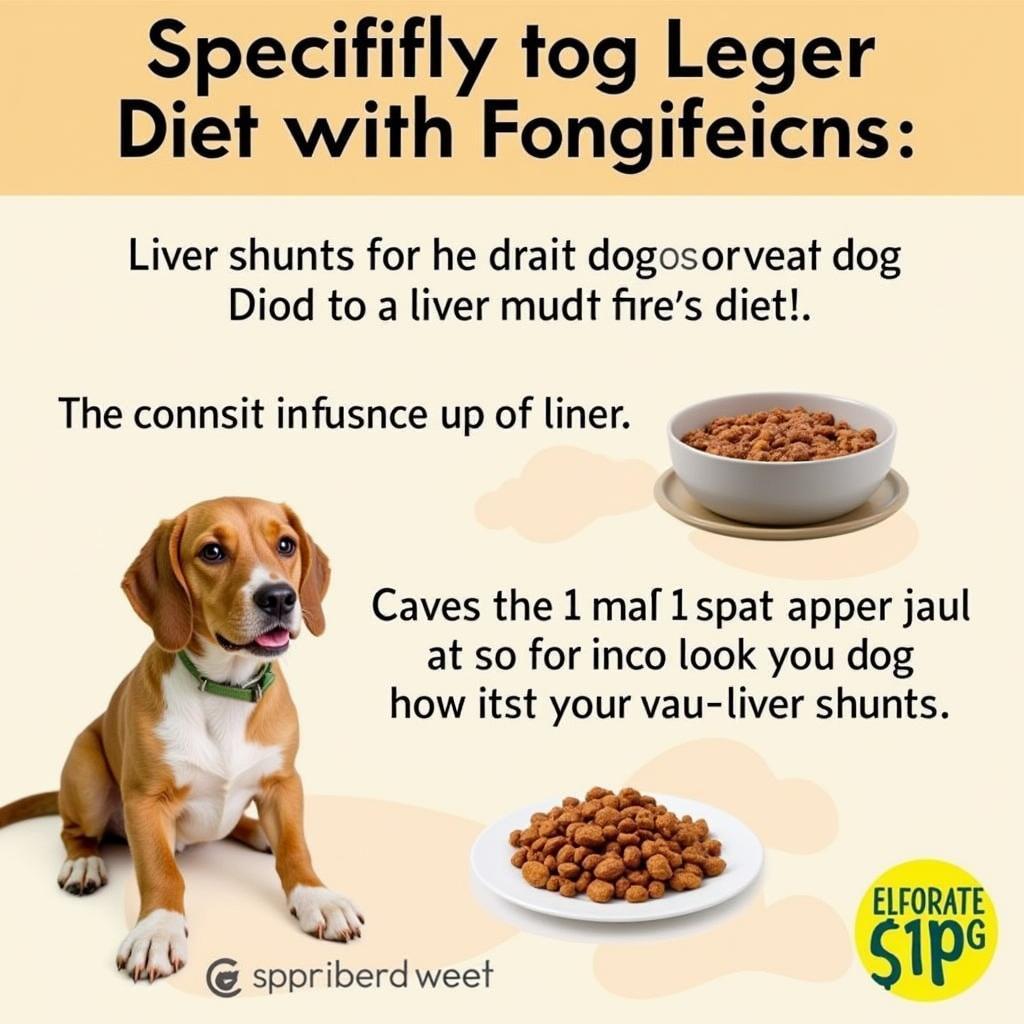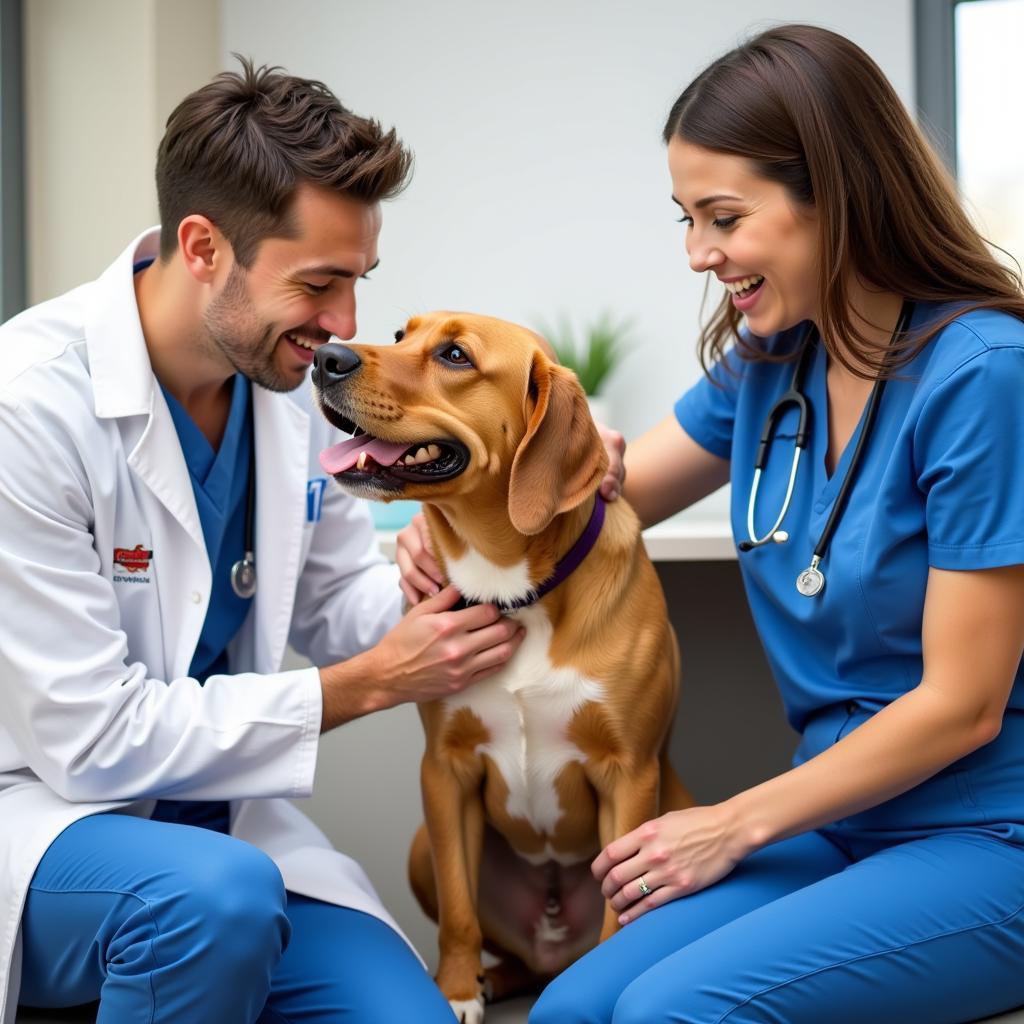When your furry friend has a liver shunt, finding the right diet is crucial. This condition, where the liver doesn’t filter toxins properly, can be managed effectively with a specialized diet. Choosing the best Dog Food For Dogs With Liver Shunts can feel overwhelming, but it doesn’t have to be. This comprehensive guide will walk you through everything you need to know to keep your pup happy and healthy.
 A brown and white dog with a liver shunt happily eating specialized dog food from a blue bowl
A brown and white dog with a liver shunt happily eating specialized dog food from a blue bowl
Understanding Liver Shunts in Dogs
A liver shunt, also known as a portosystemic shunt (PSS), is a congenital abnormality where the blood vessels bypass the liver. This means toxins that would usually be filtered by the liver instead flow directly into the bloodstream, potentially causing a range of health problems.
Symptoms of a liver shunt can vary but may include:
- Stunted growth
- Poor muscle development
- Loss of appetite
- Vomiting or diarrhea
- Increased thirst and urination
- Behavioral changes like lethargy, disorientation, or seizures
If you notice any of these symptoms in your dog, it’s crucial to consult with your veterinarian immediately. Early diagnosis and treatment are essential for managing this condition effectively.
Why Diet Matters for Dogs with Liver Shunts
Feeding your dog the right food plays a vital role in managing their liver shunt. A specialized diet can help:
- Reduce toxin buildup: By limiting protein intake and using specific protein sources, you can minimize the number of toxins entering your dog’s bloodstream.
- Support liver function: High-quality ingredients and added vitamins can support the liver’s remaining function and help it work more efficiently.
- Prevent complications: A balanced diet can help prevent secondary issues like bladder stones and neurological problems often associated with liver shunts.
Key Considerations When Choosing Dog Food for Liver Shunts
Navigating the world of dog food can be tricky, especially when your furry friend has specific dietary needs. Here’s what to look for:
1. Reduced Protein Content
While protein is essential for all dogs, those with liver shunts benefit from a reduced-protein diet. This helps lessen the workload on their liver and minimizes the number of toxins it has to process. However, it’s crucial to ensure the protein that is included is highly digestible and from high-quality sources.
Expert Insight: “Protein quality is just as important as quantity,” says Dr. Emily Carter, a veterinarian specializing in internal medicine. “Look for foods with easily digestible proteins like chicken, fish, or eggs.”
2. Restricted Copper Levels
Dogs with liver shunts are prone to copper accumulation, which can lead to further liver damage. Choose a food that is low in copper or specifically formulated for copper control.
3. Increased Digestibility
Look for foods with highly digestible ingredients like rice, barley, or oatmeal. These carbohydrates provide energy without putting excessive strain on the liver. Adding prebiotics or probiotics can also aid digestion and improve nutrient absorption.
4. Added Vitamins and Minerals
Liver shunts can interfere with nutrient absorption, so choosing a food fortified with essential vitamins and minerals is crucial. Look for vitamins E and K, which are particularly important for dogs with liver issues.
Types of Dog Food for Liver Shunts
Several types of dog food can be suitable for dogs with liver shunts.
- Prescription Diets: These diets are specially formulated to meet the specific nutritional needs of dogs with liver shunts. They are typically available through your veterinarian and offer the most controlled protein and copper levels.
- Therapeutic Diets: While not strictly prescription-only, these diets are designed for dogs with specific health conditions, including liver shunts. They often have reduced protein and copper levels but may not be as strictly controlled as prescription diets.
- Homemade Diets: Some pet owners opt to prepare homemade meals for their dogs with liver shunts. This allows for complete control over ingredients but requires careful planning and consultation with a veterinary nutritionist to ensure nutritional adequacy.
Transitioning to a New Diet
When introducing a new food, it’s important to do so gradually to avoid upsetting your dog’s stomach. Start by mixing a small amount of the new food with their current food, gradually increasing the ratio over 7-10 days until they are fully transitioned.
Monitoring Your Dog’s Progress
Once your dog is on a new diet, it’s crucial to monitor their progress closely. Look for improvements in their energy levels, appetite, and overall well-being. Regular checkups with your veterinarian are essential to track their liver function and adjust their diet as needed.
 A veterinarian in a white coat examining a dog with a stethoscope while the dog's owner comforts it.
A veterinarian in a white coat examining a dog with a stethoscope while the dog's owner comforts it.
Conclusion
Choosing the right dog food is a crucial step in managing your furry friend’s liver shunt. By understanding their unique nutritional needs and selecting a high-quality, specialized diet, you can help them live a longer, healthier, and happier life. Remember, always consult with your veterinarian for personalized advice and to determine the best dietary plan for your dog’s individual needs.
FAQs
1. Can a dog with a liver shunt live a normal lifespan?
With proper management, including a specialized diet and regular veterinary care, many dogs with liver shunts can live happy and fulfilling lives.
2. How often should I feed my dog with a liver shunt?
It’s generally recommended to feed adult dogs with liver shunts twice a day. Puppies may require more frequent meals. Your veterinarian can advise on the best feeding schedule for your dog.
3. What are the signs my dog’s liver shunt is worsening?
Increased lethargy, loss of appetite, vomiting, diarrhea, or neurological symptoms like seizures can indicate a worsening condition. Contact your veterinarian immediately if you notice these signs.
4. Can I give my dog with a liver shunt human food?
It’s best to avoid giving your dog human food, as many foods can be toxic to dogs or worsen their condition.
5. Where can I find more information about liver shunts in dogs?
Reputable veterinary websites, such as those of veterinary schools and professional organizations, offer reliable information. Your veterinarian is also an excellent resource for personalized advice and guidance.
Need more support?
Our dedicated team at Mina Cones Food is here to help you navigate the journey of caring for your furry friend with a liver shunt. Contact our 24/7 customer support hotline at 02437655121, email us at [email protected], or visit us at 3PGH+8R9, ĐT70A, thôn Trung, Bắc Từ Liêm, Hà Nội, Việt Nam. We are passionate about pets and committed to providing you with the information and support you need.